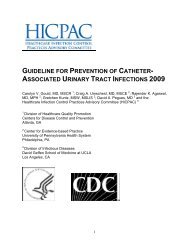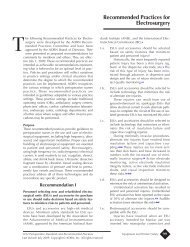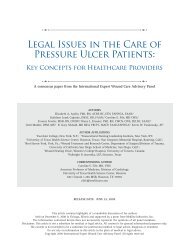Tag F-441 Compliance Aid - Medline
Tag F-441 Compliance Aid - Medline
Tag F-441 Compliance Aid - Medline
- No tags were found...
Create successful ePaper yourself
Turn your PDF publications into a flip-book with our unique Google optimized e-Paper software.
F-<strong>Tag</strong> <strong>441</strong> requirements and 2.) fail to implement preventativeor corrective measures will no longer be able to participate inMedicare – a financially devastating prospect.Non-compliance is categorized into the following levelsaccording to severity. Note that not cleaning glucose metersbetween residents falls under the most severe level ofnon-compliance.New CMS Infection ControlRequirements for Long-TermCare FacilitiesSeverity Level 4 – Immediate jeopardy to resident healthor safety: Non-compliance with one or more requirementshas caused or is likely to cause serious harm, impairment ordeath to a resident.Example:“The facility failed to follow standard precautions during theperformance of routine testing of blood sugars. The facilitydid not clean and disinfect the glucometers before or afteruse and did not use new glucometer lancets on residentswho required blood sugar monitoring. This practice of notcleaning and disinfecting glucometers between every useand re-using glucometer lancets created an ImmediateJeopardy to resident health by potentially exposing residentsto the spread of blood borne infections for multiple residentsin the facility who required blood sugar testing.” 1Listed below are the infection control requirementsunder F-<strong>Tag</strong> <strong>441</strong> that long-term care facilities mustfollow in order to be Medicare providers and receivereimbursement from CMS. 1“The intent of this regulation is to assure that thefacility develops, implements, and maintains anInfection Prevention and Control Program in order toprevent, recognize, and control, to the extentpossible, the onset and spread of infection within thefacility. The program will:Perform surveillance and investigation to prevent,to the extent possible, the onset and the spreadof infection.Ten Tips forCleaning andDisinfectingShared MedicalEquipmentSeverity Level 3 – Actual harm that is not immediatejeopardy: The negative outcome can include, but may notbe limited to clinical compromise, decline or the residentsinability to maintain and/or reach his or her highestpracticable well-being.Example:“The facility routinely sent urine cultures of asymptomaticresidents with indwelling catheters, putting residents withpositive cultures on antibiotics, resulting in two residentsacquiring antibiotic-related colitis and significant weight loss.” 1Severity Level 2 – No actual harm with potential for morethan minimal harm that is not immediate jeopardy:Non-compliance that results in a resident outcome of no morethan minimal discomfort and/or has the potential to compromisethe resident’s ability to maintain or reach his or her highestpracticable level of well being. The potential exists forgreater harm to occur if interventions are not provided.Example:“The facility failed to ensure that their staff demonstratesproper hand hygiene between residents to prevent thespread of infections. The staff administered medications to aresident via a gastric tube and while wearing the same glovesproceeded to administer oral medications to anotherresident. The staff did not remove the used gloves and washor sanitize their hands between residents.” 1Prevent and control outbreaks and crosscontaminationusing isolation precautions inaddition to standard precautions.Use records of infection incidents to improve itsinfection control processes and outcomes bytaking corrective actions, as indicated.Implement hand hygiene practices consistentwith accepted standards of practice, to reducethe spread of infections and prevent crosscontamination.Properly store, handle, process, and transportlinens to minimize contamination.”References1. CMS Manual. Interpretive Guidelines for Long-Term Care Facilities <strong>Tag</strong>F<strong>441</strong>. Available at: http://www.cms.hhs.gov/transmittals/downloads/R55SOMA.pdf. Accessed January 21, 2010.2. Centers for Disease Control and Prevention. Transmission of hepatitis Bvirus among persons undergoing blood glucose monitoring in long-termcare facilities: Mississippi, North Carolina and Los Angeles County,California, 2003-2004. MMWR 2005;54(09): 220-223. Available at:http://www.cdc.gov/mmwr/preview/mmwrhtml/mm5409a2.htm.Accessed January 21, 2010.1 Make a list of every piece of shared medical equipment.(Assign clinical staff to help identify and generate theequipment list.)2 Assign the cleaning and disinfection responsibility to thetype of healthcare worker who will be performing the taskwithin your policy.3 Communicate this administrative decision to all membersof your staff, both written and verbally, and document.4 Educate and train staff on proper care, maintenance, cleaningand storage of each piece of equipment. At a minimum, providethis education upon initial employment, when the equipment isreplaced with a newer model and annually. Document that thistraining has occurred.5 Select easy-to-use, EPA-registered hospital gradedisinfectants and cleaning products. Make sure the productslist which microorganisms and viruses it kills. Commoncleaners are sodium hypochlorite (bleach solution) or quaternaryammonium products. However, to help avoid warranty issuesor equipment damage, be sure to follow manufacturers’recommendations regarding which cleaning products to use.6 Clean medical device surfaces when visible blood or bloodyfluids are present by wiping with a cloth dampened withsoap and water to remove any visible organic material, andthen disinfect.7 If no visible organic material is present, disinfect the exteriorsurfaces after each use using a cloth or wipe with either anEPA-registered detergent/germicide with a turberculocidal orHBV/HIV label claim, or a dilute bleach solution of 1:10 to 1:100concentration.8 Never use alcohol to clean medical equipment such asglucose meters because it can damage the light emitting diodes(LED) readouts, causing fogging of plastic screens. Alcohol alsois not an EPA-registered detergent/disinfectant.9 Disposable professional grade wipes with a short “kill time”(60 seconds after application) can make the time spent cleaningequipment quick and easy. Limit the different types of wipesused at your facility to one or two. The more products you use,the more likely employees will become confused.10 All cleaning should be done in well-ventilated areas withgloves to protect healthcare workers’ hands.
















